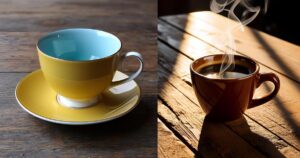Last updated on December 1st, 2025 at 06:27 pm
Teacup vs Coffee Cup — it might sound like a minor detail, but the difference can change how your drink tastes, feels, and even cools.
Most people grab whatever cup is nearby. But what if your choice is subtly ruining your perfect brew?
Think about it: a delicate porcelain teacup designed for aroma and elegance… versus a thick-walled coffee cup built for heat retention and bold flavor.
This isn’t just about looks — it’s about function, tradition, and how each cup enhances (or dulls) your experience.
Whether you’re a tea enthusiast or a caffeine-fueled coffee lover, knowing which cup to use can elevate every sip.
In this guide, you’ll get a side-by-side breakdown of materials, shape, etiquette, and purpose — so you can sip smarter.
Let’s settle this once and for all.
Teacup vs Coffee Cup at a Glance
Not sure which cup fits your drink best? Here’s a side-by-side breakdown to help you decide instantly:
| Feature | Teacup | Coffee Cup |
|---|---|---|
| Volume | 100–240 ml (tea cup capacity) | 180–360 ml (coffee mug dimensions) |
| Shape | Shallow, wide, flared | Taller, cylindrical or tapered |
| Wall Thickness | Thin (quick cooling) | Thick (heat retention) |
| Material | Porcelain, bone china | Stoneware, ceramic |
| Handle Design | Small, single-finger pinch grip | Larger, multi-finger grip |
| Saucer | Usually paired with a saucer | Often used without |
| Heat Behavior | Cools quickly to enhance tea aroma | Retains heat for longer coffee sessions |
👉 This comparison makes it clear why teacups and coffee cups are not interchangeable — form follows function.
Who Is This For?
This guide is perfect for:
Tea connoisseurs
→ If you care about subtle aromas and proper cooling, teacups are made for you.Coffee lovers
→ Prefer long sipping sessions and bold flavors? A coffee mug’s insulation is your best friend.Anyone who values tradition or presentation
→ Whether it’s a Japanese tea ritual or a morning espresso, the right cup enhances the moment.
Design & Physical Features
Let’s talk dimensions.
Teacups usually hold 100–240 ml. They’re wide and shallow to allow the tea to cool gently and release its aroma.
→ Great for light, aromatic teas like green, white, or oolong.Coffee cups range from 180–360 ml. Their taller, narrower shape helps lock in heat.
→ Ideal for slow-sipping lattes, black coffee, or espresso.
Wall Thickness & Material
Why does the wall matter?
Teacups use fine porcelain or bone china, which is:
Thin and elegant
Cools faster (important for delicate teas)
Coffee cups are usually thicker stoneware or ceramic:
Built to retain heat longer
Helps preserve flavor and aroma of hot coffee
If temperature matters to you, this detail changes the game.
Handle Design & Grip
Form meets function.
Teacup handles are:
Small and delicate
Meant for a gentle, controlled grip (usually one finger)
Coffee cup handles are:
Larger
Allow a full or multi-finger grip — for stability with heavier cups
This isn’t just comfort — it’s part of the experience.
Saucer Usage
Here’s where etiquette and culture show up.
Teacups almost always include a matching saucer.
→ It catches drips, holds the spoon, and adds elegance.Coffee cups?
→ Casual mugs skip the saucer entirely. Formal sets might include one, but it’s less common.
Pro Tip: Pairing your cup with a saucer elevates presentation and tradition — especially with guests or formal settings.
Read Also:
👉 6-inch 20 oz Coffee Mug Cup Holder
👉 Rocket Pop Twisted Tea
Thermal Dynamics & Functional Use

Coffee and tea behave differently in the cup. So your choice of cup matters more than you think.
Coffee cups are built for insulation.
Thicker ceramic or stoneware walls hold heat.
Narrower shapes reduce surface area, keeping your brew hotter longer.
Ideal for sipping over time — think work desks, long conversations, or slow mornings.
Teacups, on the other hand, are designed to cool the drink quickly.
Thin bone china or porcelain walls release heat faster.
Wider surface area helps bring tea to the right temperature for aroma release.
Perfect for delicate teas that should never be scalding hot.
Choosing the wrong cup can ruin the flavor and experience.
If you’re drinking green tea from a thick coffee mug, you’re losing subtle notes.
If you’re sipping black coffee from a dainty teacup, it may cool too fast to enjoy.
Sipping Behavior
The way you sip changes based on the cup — and it’s no accident.
Tea drinking is designed around small sips.
A teacup’s shape allows aroma to rise and cool naturally.
The size promotes mindful, measured drinking.
This matches tea culture’s emphasis on calm, presence, and flavor clarity.
Coffee, by contrast, is about fuller, longer sips.
The coffee cup supports larger volume per sip.
It holds heat longer so you can pace yourself.
Suited for bolder flavors and bigger caffeine hits.
This isn’t just a design detail.
It’s a functional decision rooted in how each drink is meant to be enjoyed.
Cultural & Historical Context
Both cups come from rich cultural traditions.
Teacups originated in ancient China.
Early versions had no handles and were made of fine porcelain.
As tea spread to Europe in the 1600s, handles and saucers were added for formality and comfort.
Teacups became symbols of refinement, hospitality, and etiquette.
Coffee cups and mugs have older, more rugged roots.
Mugs date back to 4000 BC and were originally made from wood or bone.
Ceramic mugs emerged with advancements in pottery.
By 600 CE, porcelain mugs became common across the Islamic world and Europe.
While teacups evolved for elegance and ceremony, coffee mugs evolved for practicality and durability.
Formal vs Informal Settings
There’s a reason teacups show up at formal events, while mugs dominate kitchen counters.
Teacups are tied to tradition.
Used in Japanese and British tea ceremonies.
Always served with a saucer.
Often accompanied by ritual: posture, hand position, and even silence.
Coffee cups, especially mugs, belong to casual culture.
Used at home, in cafés, and at work.
Rarely paired with a saucer unless part of a formal set.
Practical, versatile, and designed for convenience.
Understanding this distinction helps you choose the right cup — not just for the drink, but for the occasion.
Specialty Variations & Measurement Units
Espresso / Demitasse Cups (50–100 ml)
If you’re drinking espresso, you’re dealing with intensity and precision. The right cup matters.
Demitasse cups typically hold 50–100 ml of liquid.
They’re small, thick-walled, and designed to preserve the crema and heat.
The word demitasse literally means “half cup” in French.
Why does it matter?
Using a large coffee mug for a shot of espresso dilutes the visual appeal and cools it too quickly.
Espresso cups are built for insulation and portion control.
If you’re serious about espresso, don’t use the wrong vessel.
Japanese Yunomi (Handle-less Teacups)
The yunomi is a traditional Japanese teacup used for everyday tea drinking.
Typically made of ceramic or porcelain.
Handle-less and taller than Western teacups.
Holds between 90–180 ml, depending on design.
Why it works:
The cup is held with two hands, promoting a mindful, grounded experience.
Perfect for green tea, especially sencha or matcha.
This cup emphasizes warmth, presence, and balance over formality.
Mug vs Cup Terminology & Recipes
Not all cups are created equal — especially in the kitchen.
In cooking, the term “teacup” is often used as a measurement unit.
A standard teacup = 150 ml, while a US measuring cup = 240 ml.
Mugs, on the other hand, vary in size and are not reliable for recipes.
Why it matters:
Swapping one for the other can ruin baking accuracy.
Always verify whether a recipe means a literal teacup or a standard measuring cup.
Use the right unit to avoid surprises in your cooking and baking.
Aesthetic & Experiential Factors
Your cup isn’t just functional — it’s visual and sensory.
Glass or fine porcelain cups let the color of the beverage shine.
Tea drinkers especially benefit from seeing clarity and steep strength.
For coffee, transparent mugs highlight crema layers and latte art.
Smell also plays a role.
A wide-mouthed teacup or glass mug enhances aroma diffusion.
The narrower opening of a coffee cup contains and concentrates the scent.
The takeaway? The shape and material of the cup actively influence what you taste and smell.
Decorative Value & Collectibles
Some cups are made to impress — not just serve.
Bone-china teacups with intricate patterns are collector favorites.
Many are paired with saucers and gold-rimmed accents.
Limited-edition mugs and porcelain tea sets hold both aesthetic and monetary value.
If presentation matters — for hosting, gifting, or collecting — choose a cup with design in mind.
Function meets form, especially in settings where tradition or beauty matters.
Conclusion
Teacup vs Coffee Cup isn’t just a style debate—it’s about temperature, aroma, function, and experience.
Teacups are elegant, fast-cooling, and perfect for delicate teas. Coffee cups are sturdy, heat-retaining, and built for bold brews.
Your choice should depend on what you’re drinking, the setting, and how you want to enjoy it.
Whether it’s a quiet tea ritual or a bustling coffee break, the right cup elevates every sip.
Ready to dig deeper?
Explore our guides on cup vs mug, espresso accessories, and tea etiquette to level up your beverage game.
FAQs
Why Are Teacups Smaller Than Coffee Cups?
Teacups are smaller because certain teas—like green or oolong—are meant to be sipped in smaller, more delicate quantities.
The size helps the tea cool quickly, unlock aroma, and preserve flavor without overheating.
In contrast, coffee mugs are larger and built to hold more liquid for extended sipping.
Can I Drink Coffee from a Teacup?
You can, but it’s not ideal.
Teacups aren’t designed for heat retention or volume. Your coffee may cool too quickly and lose flavor.
Stick to coffee cups or mugs for the best temperature and taste experience.
Does Cup Shape Influence Taste?
Yes—cup shape affects aroma delivery, sip feel, and even perceived flavor.
A wide, shallow teacup enhances aroma but loses heat faster.
A tall, narrow coffee mug traps warmth and concentrates aroma, especially for bold brews like espresso or dark roast.
Should Espresso Always Be in a Demitasse?
Yes. A demitasse cup (50–100 ml) is the gold standard for espresso.
It preserves the crema, concentrates heat, and delivers the full flavor in a single shot.
Using a larger cup thins out the experience and ruins the crema.
Are Mugs Better for Heat Retention?
Absolutely. Coffee mugs, especially thick ceramic or stoneware, are built to hold heat longer.
They’re perfect for casual, long-drinking sessions.
Teacups, by contrast, are designed for fast cooling—ideal for lighter teas that shouldn’t stay hot for long.

Shahriar brings a unique blend of storytelling prowess and digital expertise to Daily Coffee Guide. With a background in SEO and content strategy, he ensures our articles on Beans, Coffee, Tea, and Drinks are both engaging and discoverable. His passion for coffee culture drives him to explore and share the rich narratives behind every cup.

